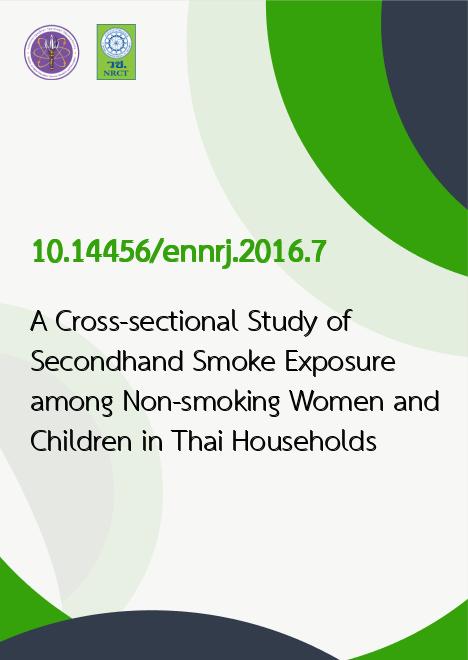
|
A Cross-sectional Study of Secondhand Smoke Exposure among Non-smoking Women and Children in Thai Households |
|---|---|
| รหัสดีโอไอ | |
| Creator | 1. Punyarat Lapvongwatana 2. Nipapun Kungskulniti 3. Naowarut Charoenca 4. Erika Avila-Tang 5. Heather Wipfli 6. Stephen L.Hamann |
| Title | A Cross-sectional Study of Secondhand Smoke Exposure among Non-smoking Women and Children in Thai Households |
| Publisher | Faculty of Environment and Resourdce Studies,Mahidol University |
| Publication Year | 2559 |
| Journal Title | Environment and Natural Resources Journal |
| Journal Vol. | 14 |
| Journal No. | 1 |
| Page no. | 51-57 |
| Keyword | Secondhand Smoke,Women and Children,Nicotine in Hair and Air,Urban,Rural |
| ISSN | 16865456;24082384 |
| Abstract | Exposure to secondhand smoke (SHS) among women and children indoors is a problem both in urban and rural environments. This study aimed to describe SHS exposure by women and children in Thai households. It is the first study of its kind in Thailand to characterize levels of nicotine in the air of homes with smokers and the extent of personal exposure to nicotine among women and children living in homes with smokers in urban and rural environments. A cross-sectional survey of nicotine exposure of 40 pairs of adult nonsmoking women and children in households with and without smokers was conducted using a questionnaire, passive air monitors, and hair samples of women and children in Bangkok and rural Mukdaharn. Questionnaire data were represented descriptively, while environmental (passive samplers) and metabolic samples (hair nicotine) used established laboratory analysis and statistical measures of association with smoke exposure. Data were analyzed and reported as percentages, means, medians, interquartile ranges, and from skew and log-10 transformed data for Pearson correlation coefficient analysis. Attention was given to results for insight to how exposure results differed between household locations (urban versus rural) and persons exposed (non-smoking adults versus children). Most smokers (81.8%) smoked inside the house and near their children. Hair nicotine level in women and children showed exposure to SHS. Hair nicotine levels among children were significantly higher than the women (p=0.038). Exposure to SHS was present with high levels of hair nicotine among women and children in both rural and urban environments when smoking was present. SHS exposure warrants increased attention due to the potential harm to non-smoking women and children reflected in these findings. |